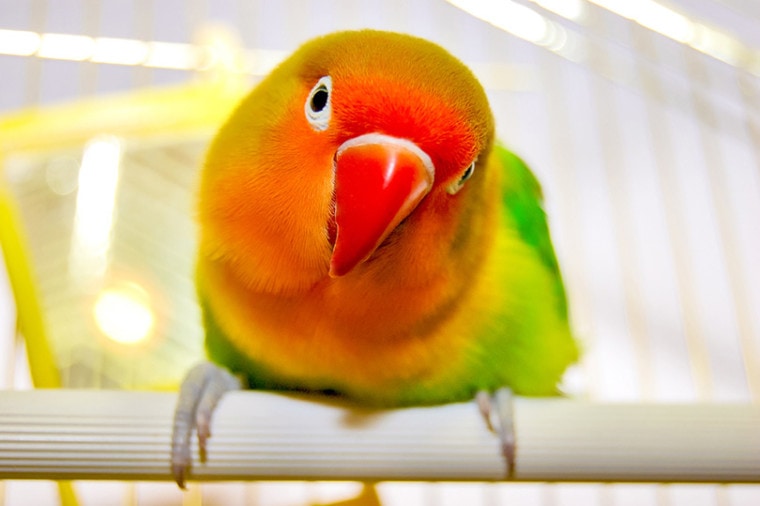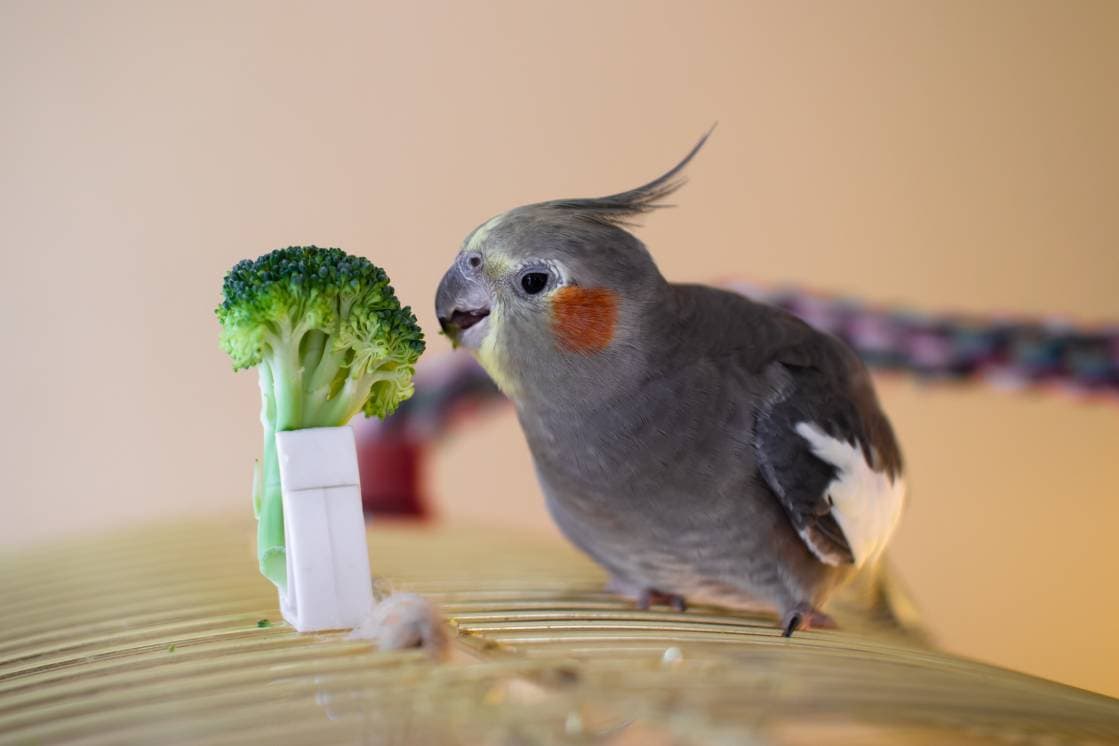
Red-Headed Lovebirds are cartoonishly adorable parrots with vibrant colors. With proper care, they can be kept as a pet that will be with you for years. Birds can be challenging pets, though, and the Red-Headed Lovebird is sensitive and timid, which can lead to stress for the bird and frustration for an unprepared owner. They are not commonly kept as pets because of their nervous nature. Keep reading for everything you need to know about the Red-Headed Lovebird.
Species Overview

| Common Names: | Red-Headed Lovebird, Red-Faced Lovebird |
| Scientific Name: | Agapornis pullarius |
| Adult Size: | 6 inches |
| Life Expectancy: | 15 years |
Origin and History
Like all Lovebirds, the Red-Headed Lovebird is native to Africa. They are specifically from Western and Central Africa, as well as Sao Tome Island in the Gulf of Guinea. They are found in lowland savannas, rainforests and woodlands, and open spaces like agricultural land. They are on the IUCN Red List as a species of least concern, but their wild populations are on the decline due to habitat destruction and the wild bird trade.
In the wild, these birds live in flocks of about 30 birds that pair off during mating season. Their timid nature makes them difficult to breed in captivity. They are not popular in the bird keeping community due to their difficult level of care and high-strung temperament.
Temperament
Although shy, Red-Headed Lovebirds form strong bonds with their owner. They may also form strong bonds with other Lovebirds, but some Lovebirds are known for being territorial and aggressive toward others. This territoriality may even carry over to other types of birds, including larger and stronger birds, which can lead to squabbles that can lead to injury.
When they’re comfortable in their environment, they are playful and curious birds that are also known for their snuggly nature with their owner. They are escape artists that require games, puzzles, and social interaction to prevent boredom and stress. If they fail to form a bond with anyone in the household, they may become aggressive toward people or exhibit signs of stress. These birds are known for biting when irritated.
Speech & Vocalizations
These birds produce a musical but quick, high-pitched call. This call most often occurs in the wild during flight with their flock. They do vocalize frequently, though, and may even be considered a nuisance by housemates or neighbors due to their frequent, loud, shrill sounds. Although they can learn to speak a few words, most Lovebirds don’t learn any speech. When they do learn it, it may be difficult to understand.
Red-Headed Lovebird Colors and Markings
Red-Headed Lovebirds are green parrots with a short tail. The body is usually mostly solid bright green, but some do have darker or lighter patches of green across the body. The males have red on the face and chin that can vary from orange red to bright red. Females, on the other hand, tend to have slightly subdued colors on the face, with their face colors ranging from peach to a soft orange. The facial colors have a distinct border, as opposed to the colors gently fading into the green of the body.
These birds only reach around 6 inches in length and most of their feathers are very fine and small, giving them an overall soft, somewhat downy appearance. They do have regular flight feathers, though.
The 7 Tips for Caring for the Red-Headed Lovebird
1. Cage Mates
Lovebirds may bond with another Lovebird in the household, especially if they share a cage. However, most professionals don’t recommend keeping more than one Red-Headed Lovebird because this close bonding between the two birds may lead to the birds neglecting to form close bonds with their owner.

2. Grooming
These birds love to take baths, so providing them with a shallow dish of clean water once or twice a week can help your stay clean and provide a source of entertainment and enrichment. Nail trims and the clipping of flight feathers should only be performed as needed by a properly trained individual.
3. Cage Setup
A secure birdcage with multiple perches is necessary for Red-Headed Lovebirds. A large cage that allows for flight is ideal when possible. The cage should be cleaned of waste and uneaten food regularly. Cleaning chemicals shouldn’t be used in the presence of the bird and any cleaning chemicals used in the cage should be bird safe.
4. Toys
Ensure your bird has a cuttlebone available for maintaining beak health. Provide appropriate toys, like a bird climbing gym, ladders, different types and textures of perches, mirrors, balls, bells, blocks, and activity mats.
5. Common Health Problems
6. Diet and Nutrition
The base of a Red-Headed Lovebird’s diet should be a commercial Lovebird food. This will ensure they are receiving all needed nutrients. Fruits and veggies, like corn, cucumber, melon, and spinach, should also be provided. Other foods that can be offered in moderation include eggs, grains, and unsalted nuts. These foods should make up less than 10% of the overall diet.
Commercial diets coupled with a variety of healthy fruits and veggies should meet your Lovebird’s nutritional needs without additional supplementation. However, talk to your avian vet to see if there is any supplementation your bird needs. Sometimes, females need calcium supplementation to prevent eggbinding.
7. Exercise
Provide your Red-Headed Lovebird with a variety of games and toys, as well as safe play spaces to keep it healthy and entertained. Daily socialization is necessary to developing and maintaining a healthy bond between you and your bird. Games and puzzles that keep your bird’s brain busy are a great form of mental and physical exercise.
If you have a safe, enclosed space for your bird to explore, this is a great way to provide exercise and enrichment. A room with closed doors and windows and no pets or small children present is an ideal exercise environment for your bird. Don’t leave your bird loose without supervision to prevent it from escaping or eating inappropriate items.
Where to Adopt or Buy a Red-Headed Lovebird
Since these birds are exceptionally difficult to breed in captivity, it may be difficult to find a breeder or retailer who sells birds acquired by ethical means. Wild catching Lovebirds can have a negative impact on their natural environment and populations. Finding a breeder who breeds their own Red-Headed Lovebirds is your best bet for finding ethically sourced birds.
Some big box stores sell these birds, but you may have to contact your local stores to see when they get them in stock and where they are sourced from. You may be able to find a breeder or rescue local to you that has Red-Headed Lovebirds available. Some people who are unprepared for the level of care these birds need will turn them over to rescues.
Conclusion
These adorable birds can make fantastic companions in low stress homes. However, they do require specific care and time, and patience to form bonds and settle into your home. If you can provide an excellent home to a Red-Headed Lovebird, you’ll be rewarded with up to 20 years of companionship from an intelligent, sensitive bird.
Featured Image Credit: Heidy Hills, Shutterstock







